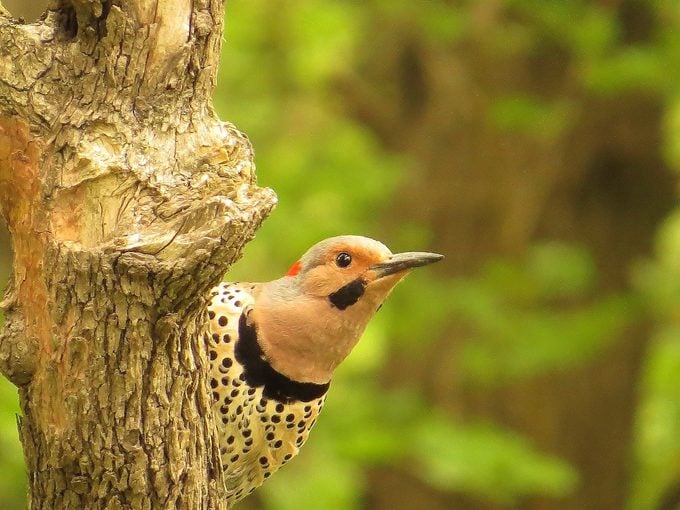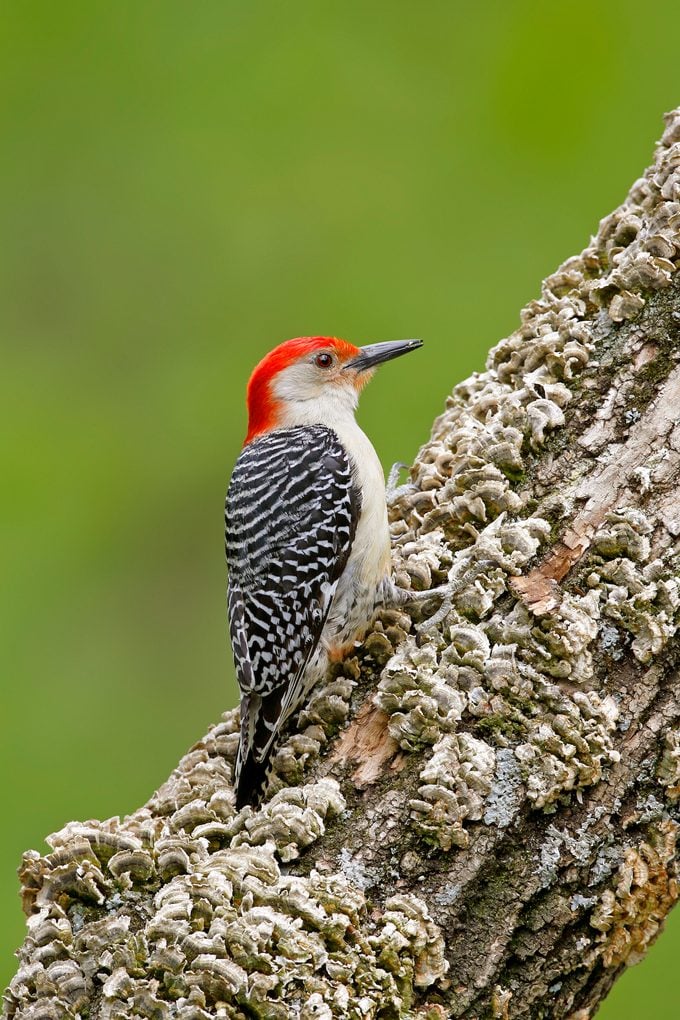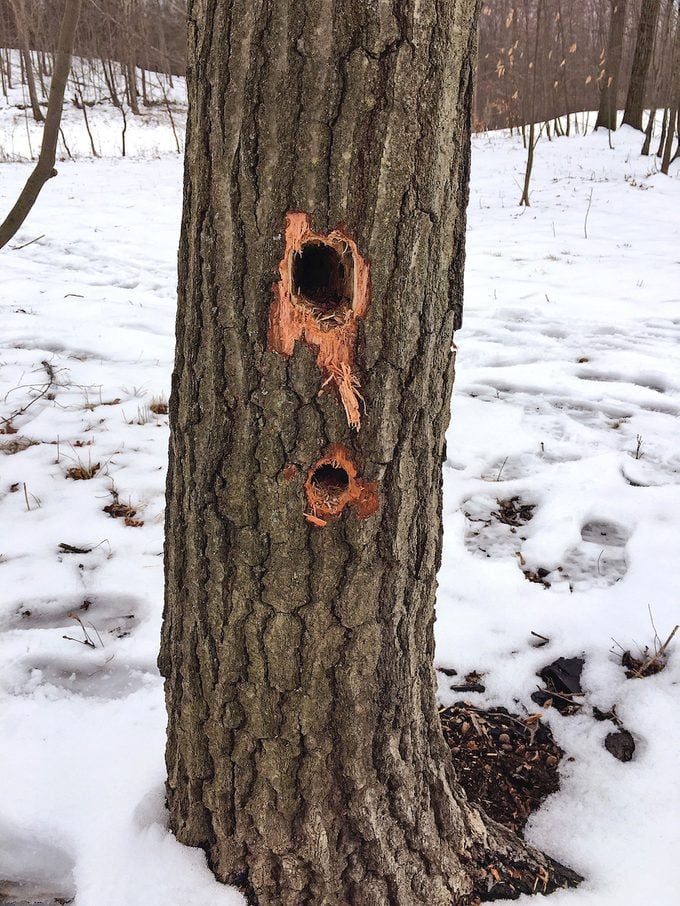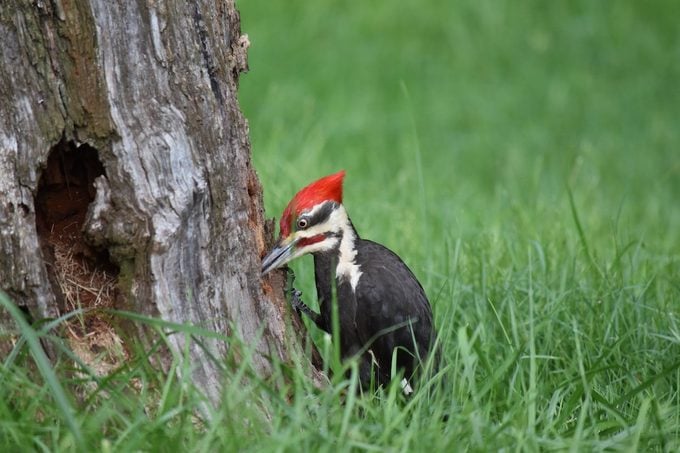Why Do Woodpeckers Peck and How to Stop Them
Updated: Feb. 08, 2024
Woodpeckers have a unique way to drum up attention. Learn why woodpeckers peck wood, trees and metal and how to stop and deter them.
How to Deter Woodpeckers and Stop Them From Pecking on Houses
“Acorn woodpeckers are fun to watch, but they peck and are eating my house. They won’t slow down, no matter what season! What can I do to get rid of the woodpeckers?” asks Bill Snow of Bear Valley Springs, California.
Birding experts Kenn and Kimberly Kaufman: There are several reasons acorn woodpeckers might be pecking at your house. They could be going after insects tunneling in the wood, making holes for storing acorns, or even trying to dig a hole for a nest.
You may be able to scare them away temporarily by filling in and painting over the holes they’ve made. To discourage woodpeckers from coming back, try hanging up something that will make noise when it blows in the breeze, or hang up long strips of aluminum foil. A company called Bird-X makes a product, Irri-Tape, designed to scare birds away from spots like this.
Discover mind-blowing woodpecker facts you should know.
Stop Woodpecker Damage on the Garage
“Woodpeckers are making large holes in the wood trim of my garage. How can I stop this behavior?” asks Deborah Bowie of Saco, Maine.
Birding expert George Harrison: Your problem is common in communities full of large trees where woodpeckers live. The reason these birds drill on trim and siding is not to find food, but to make noise. Woodpeckers don’t sing like robins and bluebirds, but they do communicate with one another by drilling loudly on wood or metal.
Getting rid of woodpeckers is not easy. You can cover the spot where they’re drilling with sheet metal or canvas, but they may move to another part of your garage. Chemicals don’t work because these birds can’t smell or taste. You could try hanging reflective balloons or streamers at the location. A fake snake or owl sometimes works as well.
Do woodpeckers kill or damage trees?
Why Do Woodpeckers Peck on Metal?

“Why do woodpeckers peck at metal chimney caps, and can I prevent it?” asks James Gates of Lemoyne, Pennsylvania.
Kenn and Kimberly: While many birds sing to claim their territories, woodpeckers have a different method. Woodpeckers knock on hard surfaces like wood to communicate with others, to claim territory and to attract a mate. One bird may drum more than 8,000 times per day, and a downy woodpecker typically strikes 16 times per second. They typically find a dry, brittle tree limb and drum on it, hammering with rapid bursts.
Like other members of the woodpecker family, northern flickers sometimes use man-made objects to drum up attention. Much to the dismay of many homeowners, northern flickers often go the extra mile, using chimneys and house gutters to amplify their announcements.
If they find a metal object to drum on, like your chimney cap, it may echo even more loudly than a dead wooden branch. This is usually seasonal behavior and shouldn’t last more than a few weeks. But if you want to take action, buy flexible foam or plastic padding from a hardware store and wrap it around the metal cap. The muffled sound should encourage woodpeckers to drum elsewhere.
Discover 13 types of woodpeckers birders should look for in North America.
Woodpecker Pecking on Gutters

“A male red-bellied woodpecker hammers on our gutter early in the morning. Why does he do this, and will it continue?” asks Dale McCarter of West Chester, Pennsylvania.
Kenn and Kimberly: Woodpeckers drum loudly on hard surfaces for the same reasons that songbirds sing loudly: to communicate with others of their kind, to announce claims to a territory or to attract a mate.
In the forest, woodpeckers will find a dry, dead tree with good echoing qualities, but around houses they may discover that banging on metal pipes and gutters produces an even louder sound. And early morning is when they’re most likely to perform these unwanted drum solos. They may drum like this at any time of year, but less frequently in fall after the breeding season is over.
Meet the sapsucker birds: woodpeckers with a sweet tooth.
Why Do Woodpeckers Peck on Wood and Trees?

“Where did these holes in my tree come from?” asks Linette Benes of Newton, New Jersey.
Kenn and Kimberly: Although we can’t be certain just by looking at the photo, this may be the work of a pileated woodpecker. These big woodpeckers feast on carpenter ants, and if a tree is filled with ant colonies, the pileateds take out big sections of the wooden trunk to get to them.
Even though pileateds are large and flashy, they’re surprisingly inconspicuous and out in the woods most of the time, so that could explain why you haven’t seen them. It’s important to realize that woodpeckers don’t dig cavities in or damage healthy trees—they only peck at wood already infested with ants.
Learn how woodpeckers use their tongues.

“I have been trying for years to photograph this elusive pileated woodpecker (above), the largest woodpecker in North America. But it was either too far away or too skittish. I came home from work in June and heard its call in the woods behind my house in southwest Pennsylvania. A few seconds later, I heard a loud pecking. The woodpecker was digging for dinner on an old ash tree stump in my backyard,” says reader Josh Doty.
Learn everything you need to know about red-headed woodpeckers.
Stop Woodpeckers From Pecking Windows
“Woodpeckers drill on our windows. We’ve tried hanging CDs as well as motion activated spiders. The spiders seem to work best; however, they are not 100 percent effective. Do you have any other suggestions?” asks Lynn Meyer of Cedar Creek, Texas.
Kenn and Kimberly: Woodpeckers use drumming as a form of communication. Hard surfaces like windows, tin roofs, the eaves of your house, or aluminum siding provide great amplification, so they often attract these feathered percussionists. Discouraging them can be a challenge, but you’re on the right track.
Any item that moves or flutters makes a good woodpecker deterrent, and reflective streamers are the most effective. One DIY approach is to cut a mylar balloon or aluminum foil into thin streamers, tape them to a dowel rod and attach the whole thing to the top of your window. Some homeowners have had success providing alternative surfaces to lure woodpeckers away from their house by fastening a section of metal roofing to a post.
Next, find out why you might see a woodpecker at a hummingbird feeder.




















